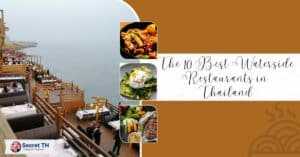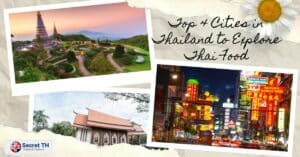Ko Samui, a quintessential Thai island, is a melting pot of cultures, offering rich traditions and a vibrant culinary scene. Its gastronomic delights, deeply rooted in the island’s history, provide a unique blend of flavors and techniques, making it a paradise for food enthusiasts.
The island’s food culture, deeply steeped in its rich history, serves up an extraordinary medley of flavors and techniques that promise to tantalize your taste buds. So, join us as we unravel the culture and cuisine of Ko Samui, offering you a virtual tour into this paradise of epicurean delights. Buckle up, food enthusiasts, for an unforgettable taste of Thailand!
An Introduction to Samui’s Rich and Varied Cultural Offerings
Samui, a scenic island located in the Gulf of Thailand, has a diverse and vibrant cultural landscape. It attracts tourists from all corners of the globe. Home to a myriad of traditions, customs, and festivals. It offers a unique blend of rich history and contemporary lifestyle. Its cultural offerings range from ancient temples showcasing Thai architecture, to local markets bustling with artisanal crafts.
Their culinary delights reflect its unique gastronomical heritage. The island’s traditional dance and music performances are often held at cultural festivals. They provide a glimpse into the heart of Samui’s community. As an island preserved from excessive urbanization, Samui offers an authentic cultural experience. This makes it a must-visit destination for culture enthusiasts.

Exploring Samui’s Culture
This island is a treasure trove of diverse traditions. It has mesmerizing architecture, lively local markets, and an exceptional culinary scene. Filled with vibrant festivals and heartfelt performances. Samui offers an unfiltered look into its community’s soul. Resisting the wave of excessive urbanization. It has managed to preserve its authentic cultural charm, making it a paradise for culture enthusiasts.
Thai Temples and Architectural Wonders
One cannot talk about Samui’s rich cultural offerings without mentioning its awe-inspiring temples and architectural gems. The island’s temples, or ‘Wats’, such as Wat Phra Yai and Wat Plai Laem, are not just places of worship. They are also integral to the island’s cultural landscape. These temples are adorned with intricate designs and statues. They reflect deep-rooted Buddhist traditions and Thai architectural styles. Visitors are often left amazed by the attention to detail and the serene ambiance of these cultural sites.

Types Of Thai Architecture
Traditional Thai Architecture
Religious Structures
Traditional Thai architecture is primarily embodied in religious structures. It is a testament to Thailand’s rich cultural heritage. It is characterized by multi-tiered roofs, upward-curving ends, and ornate carvings. They represent a unique blend of aesthetics and spiritual symbolism. In Samui, these structures offer a window into the island’s past. Showcasing its deep Buddhist roots and architectural prowess.
Secular Structures
Secular structures in Samui also exemplify the finesse of traditional Thai architecture. These are primarily residential or public buildings that are not linked to religious practices. These structures, which include teakwood houses, government offices, and shops, also feature the distinctive multi-tiered roofs and ornate carvings found in religious structures. While their function may differ, these secular structures continue the tradition of Thai architecture, enriching Samui’s cultural landscape and providing a distinct local character to the island.
Given below are a few of the famous sites in Thailand that are emblematic and brilliantly showcase the architecture of Thailand.

Prasat Hin Phimai
Prasat Hin Phimai stands as a monumental testament to Thailand’s rich architectural heritage. This magnificent historical park is located in the Nakhon Ratchasima Province and is home to one of the most significant Khmer temples in Thailand. The intricately carved sandstone and laterite structures of Phimai narrate tales of an ancient era, blending Hindu and Buddhist architectural styles in a striking manner. Its impressive prangs (towers), antefixes, and pediments showcase the exceptional artistry and detail of Khmer architecture, making it a must-visit site for culture and history enthusiasts.
Location: Phimai, Nakhon Ratchasima province
Timing: 9:00 AM to 4:00 PM
Entry fee: THB 30
Structure of Architecture: Traditional

Wat Rong Khun
Wat Rong Khun, also known as the White Temple, is a contemporary, unconventional, privately-owned art exhibit in the style of a Buddhist temple in Chiang Rai Province, Thailand. This masterpiece by Chalermchai Kositpipat, a renowned Thai visual artist, is a stunning white structure reflecting an array of architectural styles.
The temple’s unique and intricate design, adorned with mirrors, stands as a symbol of purity and the reflection of Buddha’s wisdom shining across the earth and the universe. This site, with its surreal beauty and spiritual symbolism, is a must-visit for anyone exploring Thailand’s architectural wonders.
Location: Off Highway 1, Phahonyothin Road, 15 kilometres South West of Chiang Rai town
Timing: 9:00 AM to 4:00 PM
Entry fee: THB 30
Structure of Architecture: Traditional

Modern Thai Architecture
Modern Thai architecture is a captivating blend of traditional Thai elements and contemporary design practices, reflecting the country’s journey towards modernization while still holding onto its rich cultural heritage. In Samui, modern Thai architecture can be observed in newly constructed residences, resorts, and commercial buildings.
These structures incorporate traditional features like multi-tiered roofs and elaborate carvings, but with a modern twist that includes glass facades, linear forms, and minimalist aesthetics. This style represents the island’s ability to balance progress and preservation, creating a unique architectural landscape that mirrors its vibrant cultural identity.
Elephant Tower
The Elephant Tower, located in Bangkok, is an iconic representation of modern Thai architecture. This 32-story building, characterized by its unique elephant-shaped design, offers a glimpse into Thailand’s ability to integrate cultural symbolism with contemporary architectural trends. The structure, complete with eyes and tusks, is a testament to the nation’s reverence for elephants, which is deeply embedded in its cultural and historical narrative. Its bold design and dominant presence in the city’s skyline make it an unmissable landmark in Thailand’s architectural landscape.
Location: Chatuchak, Bangkok, Thailand
Structure of Architecture: Modern
Robot Building
The Robot Building, located in the Sathorn business district of Bangkok, is another prime example of modern Thai architecture. This architectural marvel, designed by Sumet Jumsai, is known for its distinct robotic façade, embodying the idea of modernization and technological advancement. The building’s design is a playful yet profound commentary on the integration of technology into daily life, symbolically mirroring Thailand’s transition into the digital era. With its prominent antennae, eyes, and metal-clad exterior, the Robot Building stands as a unique and intriguing architectural masterpiece in Thailand.
Location: 191 South Sathorn Road, Bangkok, Thailand.
Structure of Architecture: Modern
Samui Cuisine: A Taste of the Local Flavors
Eating is an integral part of life in Ko Samui. From street food stalls to high-end restaurants, you can experience a variety of flavors from around the world. Traditional Thai dishes such as som tam (papaya salad) and pad thai are popular among locals and visitors alike. For those looking for a more daring experience, you can find plenty of exotic delicacies to try, such as barbecued insects or fermented fish sauce.

- Massaman Curry: A Muslim-influenced dish, Massaman Curry is a flavorful concoction that incorporates coconut milk, tamarind, cinnamon, star anise, and a variety of other spices, producing a warm, comforting dish that is a staple in Samui cuisine.
- Tom Kha Gai: This is a classic Thai chicken soup cooked with coconut milk, lemongrass, and kaffir lime leaves. It’s a refreshing yet rich dish, and a must-try when visiting Samui.
- Khao Phat: A simple yet satisfying dish, Khao Phat is Thai-style fried rice, typically served with a variety of ingredients such as shrimp, chicken, or crab.
- Som Tum: Originally from northeastern Thailand, Som Tum is a vibrant papaya salad that combines sweet, sour, and spicy flavors. It’s an iconic part of Thai cuisine and a common sight on Samui’s food scene.
- Mango Sticky Rice: A delectable dessert, Mango Sticky Rice combines ripe, juicy mangoes with sweet sticky rice and a drizzle of coconut cream. This dish is a beloved part of Samui’s culinary landscape, providing a sweet finish to any meal.
Tips for Making the Most of Your Trip

- Do your research before you go to make sure you don’t miss any must-see attractions.
- Be mindful of local customs and dress appropriately when visiting temples or other cultural sites.
- Try something new from a street food stall – you might be surprised by what you find!
- Don’t forget to buy souvenirs for yourself or a loved one.
- Leave time in your itinerary for island hopping and sampling the nightlife.
- Above all, remember to relax and enjoy every moment of your trip!
Conclusion
To conclude, Samui, a picturesque island in the Gulf of Thailand, is not just a tropical paradise, but also a vibrant cultural hub that offers travelers a unique and authentic experience. From its awe-inspiring temples, and stunning Thai architecture, to the delightful palette of culinary flavors. Every element of Samui resonates with the island’s rich cultural heritage. A visit to Samui is an invitation to dwell in the warmth of its traditions.
Also, witness the grandeur of its architecture, and savor the essence of its culinary scene. It is a place where the old and new coexist harmoniously. It offers a cultural experience that is as diverse as it is captivating. So, whether you are a culture enthusiast, food lover, or traveler seeking a unique holiday experience. Samui promises a journey that is both enriching and unforgettable.













